Bus shelters revisited
One of Dr. Transit's most dedicated correspondents is Paul Wolf.
He recently shot this great photo, to illustrate that he thinks that glass bus shelters are a bad idea.
 Flickr photo by pbwolf.
Flickr photo by pbwolf.Dr. Transit believes that bus shelters made of glass can go beyond being convenient targets for disorder, by rethinking how such shelters connect to the neighborhood around the shelter. In "Casting Stones at Bus Shelters Made of Glass" Paul and I went back and forth on this same issue in March. But I didn't illustrate the entry.
Here are some examples of artistic bus shelters, some of glass, that would go a long way towards making bus shelters a part of the community, rather than an intrusion, and this would likely reduce vandalism directed against bus shelters (which are provided for and maintained by the separate jurisdictions, not WMATA; DC has recently contracted with Adshel for bus shelters in DC and I hope that the contract allows for artistic bus shelters outside of the installations provided by Adshel).
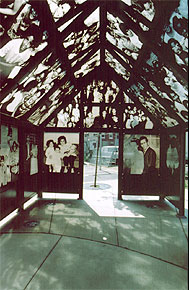 La Casita at Congreso de Latinos Unidos, Philadelphia. By Pepon Osorio, photo by Gregory Benson. This isn't a bus shelter, but it illustrates the use of glass panels (hardened to resist breakage and vandalism) featuring photos of "people like us" in this case current and older photos of people and events in Philadelphia's Latino community.
La Casita at Congreso de Latinos Unidos, Philadelphia. By Pepon Osorio, photo by Gregory Benson. This isn't a bus shelter, but it illustrates the use of glass panels (hardened to resist breakage and vandalism) featuring photos of "people like us" in this case current and older photos of people and events in Philadelphia's Latino community.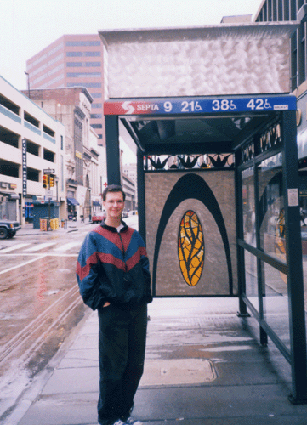 Stained glass bus shelter in Philadelphia.
Stained glass bus shelter in Philadelphia.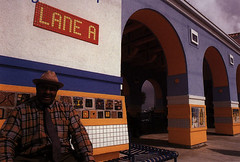 Customer sits in front of vivid tiles that distinguish the Port Ayers transfer center, San Antonio. San Antonio, with a large population of Mexican heritage, features tiles in a number of bus shelters. Tilemaking and talavera are part of the cultural tradition of Mexico (derived from Spain and Morocco.) Photo from FTA Art in Transit online publication.
Customer sits in front of vivid tiles that distinguish the Port Ayers transfer center, San Antonio. San Antonio, with a large population of Mexican heritage, features tiles in a number of bus shelters. Tilemaking and talavera are part of the cultural tradition of Mexico (derived from Spain and Morocco.) Photo from FTA Art in Transit online publication.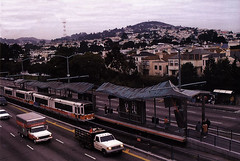 Undulating transit shelter roof in San Francisco, reflecting the undulating hills nearby. Photo from FTA Art in Transit online publication.
Undulating transit shelter roof in San Francisco, reflecting the undulating hills nearby. Photo from FTA Art in Transit online publication.Transit Waiting Environments is a publication from Kent State's Urban Design Center. Dennis Jaffe of Sierra Club's Transit campaign, extracted these points from the report:
- Waiting for the bus should be a comfortable, safe experience.
- Waiting for the bus should be a predictable experience.
- Waiting for the bus should be a convenient part of everyday life.
- Bus stops must be easily identified.
- Bus stops are a community responsibility.
- Amenities should be provided at stops serving the greatest number of potential riders.
- Areas around bus stops should be developed in transit-oriented patterns.
The most important amenities that were identified in the Cleveland study, in order of priority, were:
- Iinformation on bus arrival and the frequency of service
- Lighting
- Shelter
- Seating
- Heating in bus shelters
- A paved waiting surface
- Trash cans
- Area maps
- Bike racks
- Landscaping
 A not atypical DC bus shelter.
A not atypical DC bus shelter.
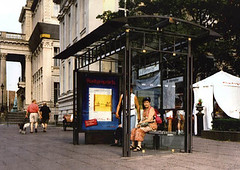 One of my favorite bus shelters (from Berlin), with a design similar to the old trolley waiting stations still extant on the grounds of the U.S. Capitol. (Photo: Project for Public Spaces via the 21st Century Streetscape online exhibition at the Municipal Arts Society website.
One of my favorite bus shelters (from Berlin), with a design similar to the old trolley waiting stations still extant on the grounds of the U.S. Capitol. (Photo: Project for Public Spaces via the 21st Century Streetscape online exhibition at the Municipal Arts Society website.



0 Comments:
Post a Comment
<< Home